Home / Fischer Esterification – Carboxylic Acid to Ester Under Acidic Conditions
Carboxylic Acid Derivatives
Fischer Esterification – Carboxylic Acid to Ester Under Acidic Conditions
Last updated: February 28th, 2025 |
Carboxylic Acid to Ester Under Acidic Conditions (Fischer Esterification)
- The conversion of a carboxylic acid to an ester under acidic conditions is commonly known as the Fischer esterification
- In this reaction there is an equilibrium between the starting materials (carboxylic acid + alcohol) and the products (ester + water).
- The equilibrium is driven to the right (ester side) through using a large excess of alcohol and also through removing any water that is formed either through use of a drying agent (dessicant) or through removal with a Dean-Stark type apparatus
- Cyclic esters can be formed under these conditions, which are known as lactones.
- The mechanism for this reaction is Protonation-Addition-Deprotonation-Protonation-Elimination-Deprotonation (PADPED).
- The reaction can be run in the reverse direction by treating the ester with excess water in the presence of acid. This is acidic ester hydrolysis.
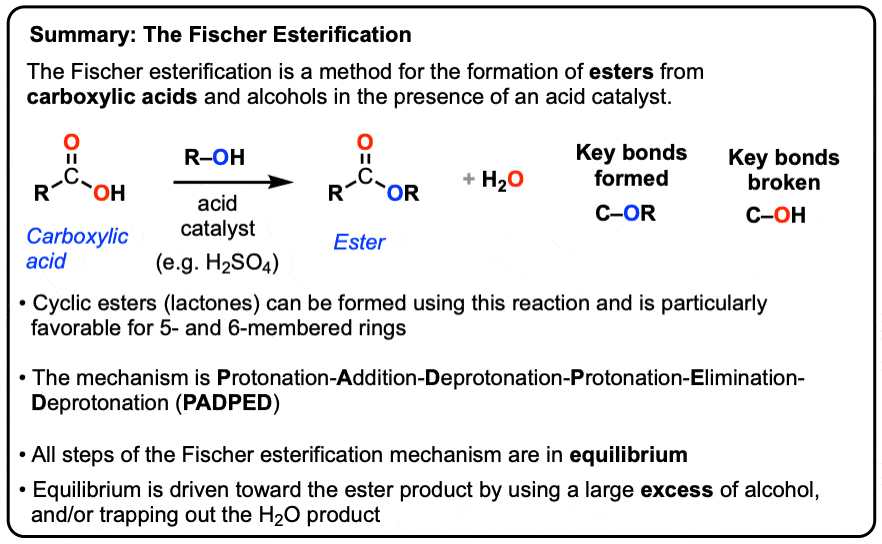
Table of Contents
- Conversion of Carboxylic Acids to Esters (Fischer Esterification)
- Intramolecular Fischer Esterification
- Mechanism of the Fischer Esterification
- Comparing Fischer Esterification With Saponification
- What Is The Driving Force?
- Using a Large Excess of Reagent
- Removing Water As It Is Formed
- Summary
- Notes
- Quiz Yourself!
- (Advanced) References and Further Reading
1. Conversion of Carboxylic Acids To Esters (Fischer Esterification)
Carboxylic acids can be converted to esters with an acid catalyst and an excess of alcohol.
This is known as Fischer esterification. or just “esterification of acids”.

Common choices for acids include sulfuric acid (H2SO4), tosic acid (TsOH) and hydrochloric acid HCl among others. For our purposes these conditions can be considered to be equivalent.
Here are some examples of the Fischer esterification.

Notice in this reaction that we form a new C-O bond and we break a C-O bond.
Importantly, we are forming and breaking the bond from the oxygen to the carbonyl, not the bond from the oxygen to the R group.
The Fischer esterification is therefore an example of nucleophilic acyl substitution.
We also form two new O-H bonds to generate a molecule of water.
2. Intramolecular Fischer Esterification
The Fischer esterification can also be used to make cyclic esters (lactones).
This is an example of an intramolecular reaction. The bonds that form and break are exactly the same! But since the nucleophile and electrophile are attached to the same molecule, we obtain a cyclic product.
Ring formation works best for the formation of 5- and 6-membered rings. [Note 1] Three and four membered rings are generally too strained to form through this method, although there are other methods for the formation of 4-membered lactone rings [Note 2].

Note that in this reaction an equivalent of water is formed.
3. Mechanism of the Fischer Esterification
So how does this reaction work?
The Fischer esterification mechanism has six steps. Each step is reversible and the starting materials and final product are all in equilibrium.
In the first step of the Fischer esterification, the carbonyl oxygen is protonated with acid to give an oxonium ion.
The resulting protonated carbonyl is an even better electrophile than a neutral carbonyl carbon.
The second step is addition of the neutral nucleophile (ROH) to the protonated carboxylic acid (Form C-O, break C-O (pi)). This results in a tetrahedral intermediate. (See post: Nucleophilic Addition to Carbonyls)
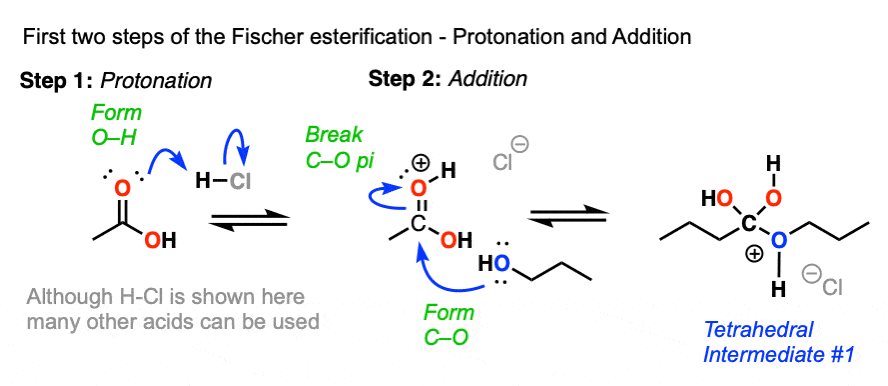
The next two steps together are known as “proton transfer” since they result in the net movement of H+ from one oxygen to another. Deprotonation of the O-H from the alcohol is followed by protonation of the O-H oxygen.

This results in formation of a good leaving group (H2O). Elimination of H2O (Form C-O (pi), break C-O) gives the protonated ester. Deprotonation of the ester then gives us the neutral ester product (and water).

A useful mnemonic for the full mechanism is the acronym PADPED.
(Protonation-addition-deprotonation-protonation-elimination-deprotonation).
This is also the mechanism of acid-catalyzed transesterification (See post: Tranesterification), as well ass acidic ester hydrolysis, imine formation, and several other reactions (See post: Learn 6 mechanisms For The Price Of One)
4. Comparing Fischer Esterification With Saponification
Why does esterification of acids work well under acidic conditions, but fails under basic conditions?
 Click to Flip
Click to Flip

Recall that a key driving force for nucleophilic acyl substitution reactions is that they are strongly favorable when the nucleophile is a stronger base than the leaving group. [See post: Nucleophilic Acyl Substitution]
When we employ acidic conditions our nucleophile is ROH and our leaving group is H2O. There isn’t a very strong driving force one way or the other, but at least it’s not unfavorable.
The key elimination step is extremely difficult under basic conditions.
If RO(-) just led to the displacement of HO(-), it would be a fine nucleophilic acyl substitution. But since carboxylic acids are acids, an acid-base reaction between the carboxylic acid and RO(-) occurs first, giving the carboxylate RCO2(-).
In order for nucleophilic acyl substitution to happen on a carboxylate, the leaving group would have to be O(2-). That’s far too unfavorable, since it’s a much stronger base than RO(-)! So getting this reaction to work is like expecting a river to flow backwards.
So using acid for this reaction makes all the difference. Since the conjugate acid is a better leaving group (See post: What Makes A Good Leaving Group) using an acid catalyst enables us to perform nucleophilic acyl substitution in situations where base alone would fail.
5. What is The Driving Force?
There’s one last question worth asking. What’s the actual driving force for the Fischer esterification?
Usually, nucleophilic acyl substitution reactions follow the Principle of Acid-Base Mediocrity. That means that reaction proceeds in the direction in which the stronger base (nucleophile) displaces a weaker base (leaving group). [See post: Nucleophilic Acyl Substitution]
But here, the leaving groups in the forward direction (H2O) and reverse direction (ROH) have roughly the same leaving group ability .
So why should it follow any direction at all?

Good question! Since there is no inherently strong driving force for the reaction, we will have to choose our reaction conditions well such that equilibrium will flow in the direction of the desired product.
There are two main ways to do this, and these two methods can be combined.
- Use a large excess of the nucleophile (alcohol) – preferably, make it the solvent.
- Remove the byproduct (water) as it is formed, which will slow down the reverse reaction.
6. Large Excess of Reagent
One study on this reaction [Note 3] used acetic acid and ethanol in the presence of an acid catalyst.
It was found that running the Fischer esterification using equal amounts of acetic acid and ethanol gave a 65% yield of the ester at equilibrium.
Not bad. But the reaction could be driven even further to the right by using a 10-fold excess of the alcohol. In this case they obtained a 97% yield of the ester.
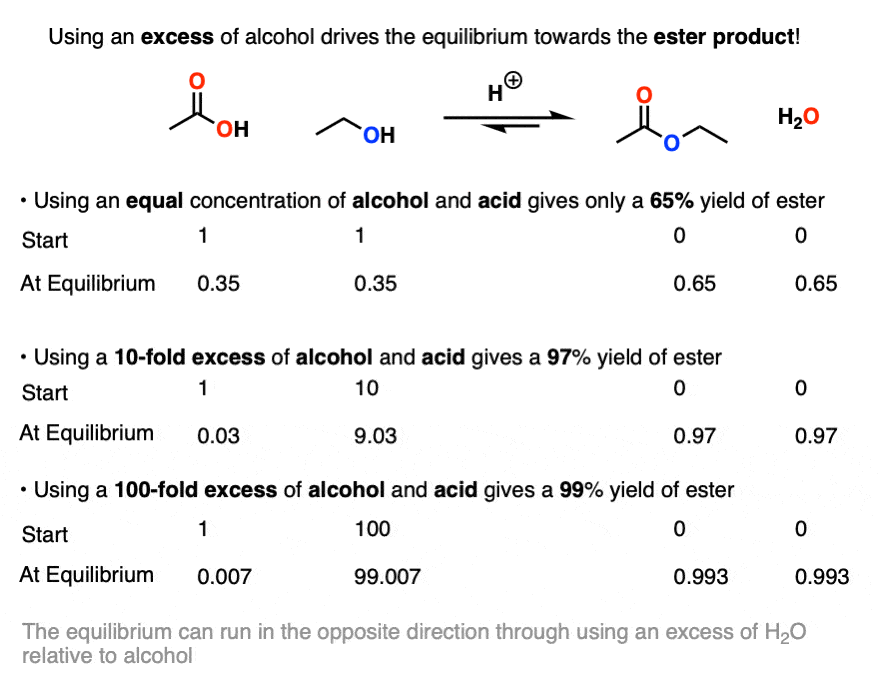
By using a 100 fold excess, they were even able to drive the reaction toward a 99% yield.
7. Removing Water With A Dean-Stark Trap
Another way to ensure the reaction runs in the direction of ester formation is to remove the water as it is formed. This pushes the equilibrium towards the right via Le Chateliers’ principle.
A clever way to do it is to use an apparatus called a Dean-Stark trap.
In this process, a solvent such as benzene or toluene is used. These molecules co-distill together to form what is called an azeotrope. The vapor condenses at the base of the reflux condenser. At this point, the liquid drops down, and the water, being more dense than toluene, sinks to the bottom of the trap.
With water removed from the reaction mixture, the reverse reaction (ester hydrolysis) is rendered impossible.
For an example, see: this (free) article (Org Syn 1949, 29, 33)
8. Summary
The Fischer esterification is one of those classic reactions in organic chemistry that is never going away.
It is one of the cheapest and most effective processes for the formation of esters from carboxylic acids, especially on large scale.
All of the steps in the Fischer esterification are potentially reversible. The six steps in the mechanism (Protonation-Addition-Deprotonation-Deprotonation-Elimination-Deprotonation) are also the six steps for the reverse reaction, the acid-catalyzed hydrolysis of esters.
Notes
Related Articles
- Transesterification
- Nucleophilic Acyl Substitution (With Negatively Charged Nucleophiles)
- Addition-Elimination Mechanisms With Neutral Nucleophiles (Including Acid Catalysis)
- Carboxylic Acid Derivatives Practice Questions
- Basic Hydrolysis of Esters – Saponification
- Making Music With Mechanisms (PADPED)
- Amide Hydrolysis
- Hydrolysis of esters to carboxylic acids with aqueous acid (MOC Membership)
- Nucleophilic Addition To Carbonyls
- Proton Transfer
- What makes a good leaving group?
Note 1. The equilibrium for the formation for unstrained, five- and six-membered rings is highly favorable for entropic reasons. A molecule of the leaving group (e.g. H2O) is released into solution with attendant increase in translational entropy (three degrees of translational entropy and up to three degrees of rotational entropy). This is sometimes known as the chelate effect. [Ref]
Note 2. Beta-lactones cannot be formed through the Fischer esterification as the four-membered ring has too much ring strain. However, beta-lactones can be formed through intramolecular closure of an alcohol onto an acid chloride or similar carboxylic acid derivative with an excellent leaving group. Beta-lactones are also found in some natural products.
Note 3. This table is adapted from page 499 of “Introduction to Organic Chemistry” (4th ed.), editors Streitweiser, Heathcock, Kosower. [link]
Note 4. Some physical properties of carboxylic acids.

Quiz Yourself!
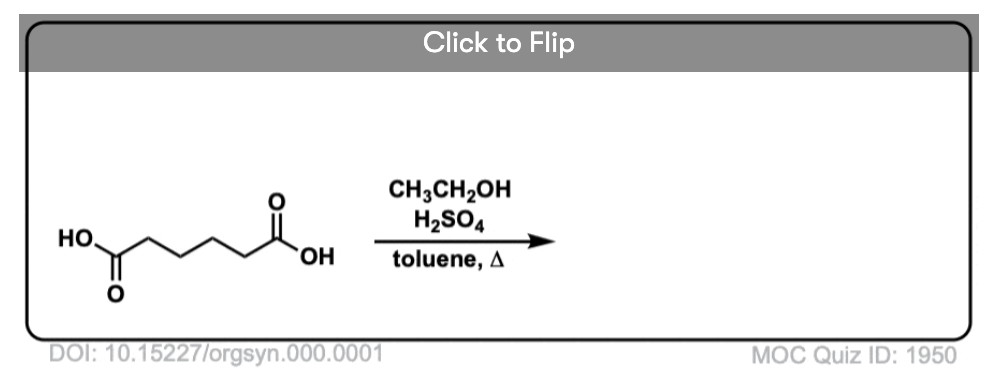
Become a MOC member to see the clickable quiz with answers on the back.
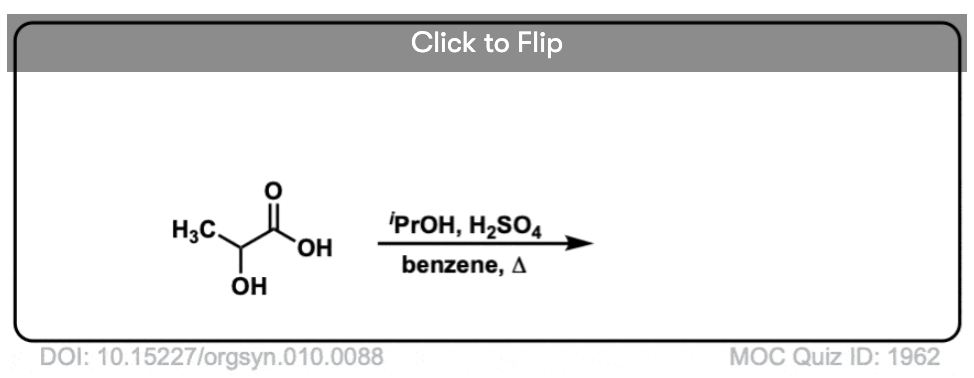
Become a MOC member to see the clickable quiz with answers on the back.
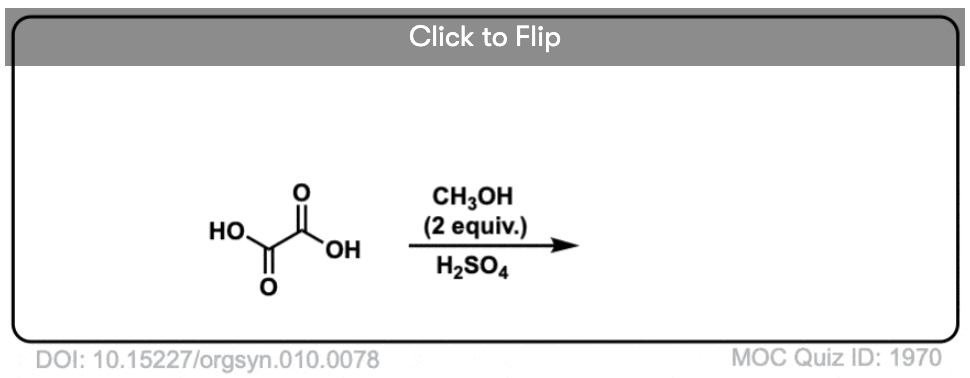
Become a MOC member to see the clickable quiz with answers on the back.

Become a MOC member to see the clickable quiz with answers on the back.
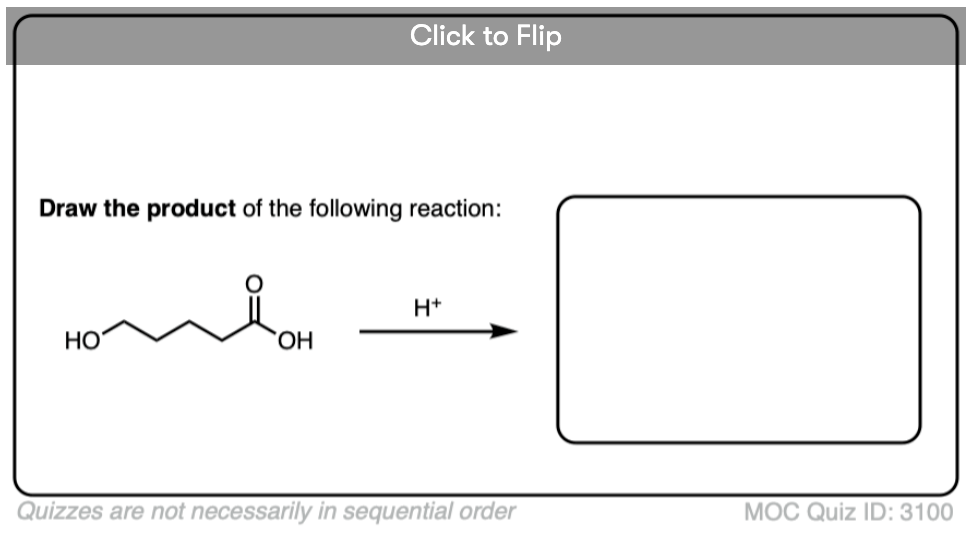
Become a MOC member to see the clickable quiz with answers on the back.
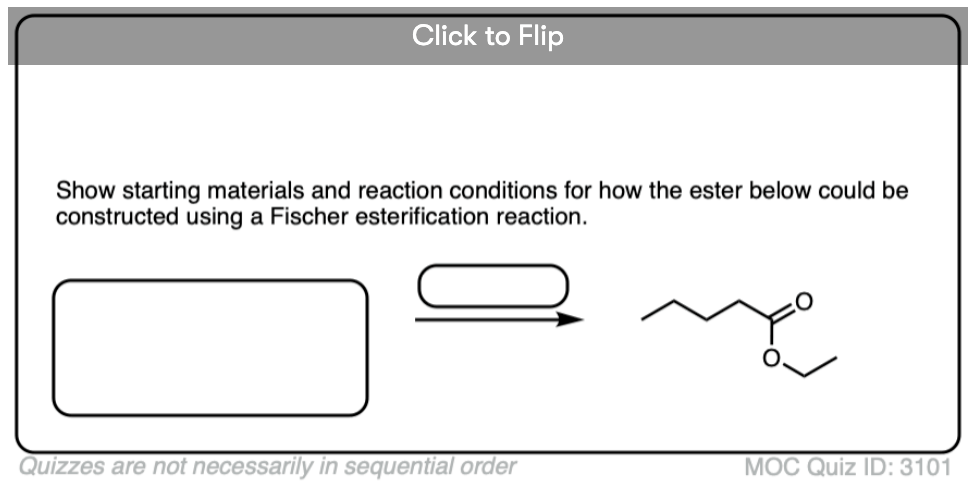
Become a MOC member to see the clickable quiz with answers on the back.
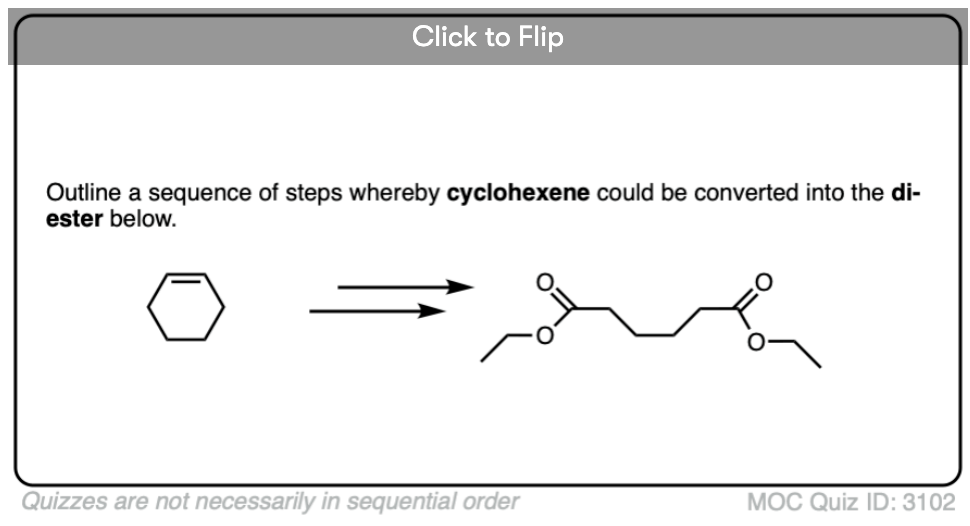
Become a MOC member to see the clickable quiz with answers on the back.
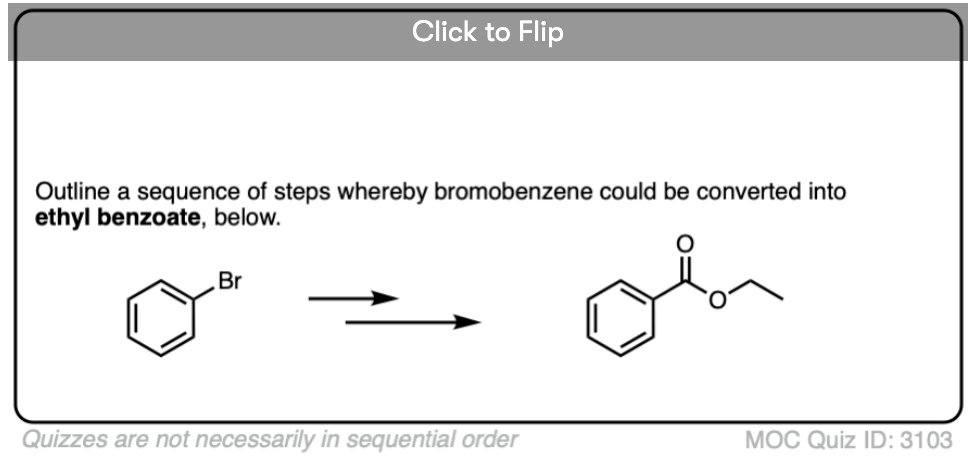
Become a MOC member to see the clickable quiz with answers on the back.
(Advanced) References and Further Reading
References
- First example
Emil Fischer, Arthur Speier (1895). “Darstellung der Ester”.
Chemische Berichte. 28: 3252–3258
DOI: 1002/cber.189502803176
Original paper by Emil Fischer and Arthur Speier describing acid-catalyzed esterification of carboxylic acids and alcohols. - Protonic States and the Mechanism of Acid‐Catalysed Esterification
Dr. H. Zimmermann Dr. J. Rudolph
Angewandte Chemie Int. Ed., Volume 4, Issue 1, January 1965, Pages 40-49
DOI: 10.1002/anie.196500401
Considerations of proton mobility in the condensed phase suggest a two-step mechanism of esterification, which proceeds via a tetrahedral intermediate. - Ethyl Adipate
M. Micovic
Org. Synth. Coll. Vol. 2, 264
DOI: 10.15227/orgsyn.000.0001
One of the first procedures in Organic Syntheses, a reliable source for reproducible organic transformations. This uses a Fischer esterification to convert adipic acid, a diacid and precursor to nylon-6,6, to ethyl adipate. - Mechanisms of Catalysis of Nucleophilic Reactions of Carboxylic Acid Derivatives.
Myron L. Bender
Chemical Reviews 1960 60 (1), 53-113
DOI: 10.1021/cr60203a005 - Phenyl acetate preparation from phenol and acetic acid: Reassessment of a common textbook misconception
M. B. Hocking
Journal of Chemical Education 1980 57 (7), 527
DOI: 10.1021/ed057p527 - Recent developments in methods for the esterification and protection of the carboxyl group
Edwin Haslam
Tetrahedron, Volume 36, Issue 17, 1980, 2409-2433
DOI: 10.1016/0040-4020(80)80219-5 - Entropic Contributions To Rate Accelerations in Enzymic and Intramolecular Reactions and the Chelate Effect
Michael A. Page and William P. Jencks
Proc. Nat. Acad. Sci. 1971, 68(8), 1678-1683
DOI: 10.1073/pnas.68.8.1678
Discussion of the chelate effect. When a new ring forms, there is a reduction in the entropy arising from restriction of the rotation alongt C-C bonds (about 4.5 entropy units per bond) but this is more than made up for by the large increase in translational degrees of freedom afforded by the release of an additional molecule into solution.
00 General Chemistry Review
01 Bonding, Structure, and Resonance
- How Do We Know Methane (CH4) Is Tetrahedral?
- Hybrid Orbitals and Hybridization
- How To Determine Hybridization: A Shortcut
- Orbital Hybridization And Bond Strengths
- Sigma bonds come in six varieties: Pi bonds come in one
- A Key Skill: How to Calculate Formal Charge
- The Four Intermolecular Forces and How They Affect Boiling Points
- 3 Trends That Affect Boiling Points
- How To Use Electronegativity To Determine Electron Density (and why NOT to trust formal charge)
- Introduction to Resonance
- How To Use Curved Arrows To Interchange Resonance Forms
- Evaluating Resonance Forms (1) - The Rule of Least Charges
- How To Find The Best Resonance Structure By Applying Electronegativity
- Evaluating Resonance Structures With Negative Charges
- Evaluating Resonance Structures With Positive Charge
- Exploring Resonance: Pi-Donation
- Exploring Resonance: Pi-acceptors
- In Summary: Evaluating Resonance Structures
- Drawing Resonance Structures: 3 Common Mistakes To Avoid
- How to apply electronegativity and resonance to understand reactivity
- Bond Hybridization Practice
- Structure and Bonding Practice Quizzes
- Resonance Structures Practice
02 Acid Base Reactions
- Introduction to Acid-Base Reactions
- Acid Base Reactions In Organic Chemistry
- The Stronger The Acid, The Weaker The Conjugate Base
- Walkthrough of Acid-Base Reactions (3) - Acidity Trends
- Five Key Factors That Influence Acidity
- Acid-Base Reactions: Introducing Ka and pKa
- How to Use a pKa Table
- The pKa Table Is Your Friend
- A Handy Rule of Thumb for Acid-Base Reactions
- Acid Base Reactions Are Fast
- pKa Values Span 60 Orders Of Magnitude
- How Protonation and Deprotonation Affect Reactivity
- Acid Base Practice Problems
03 Alkanes and Nomenclature
- Meet the (Most Important) Functional Groups
- Condensed Formulas: Deciphering What the Brackets Mean
- Hidden Hydrogens, Hidden Lone Pairs, Hidden Counterions
- Don't Be Futyl, Learn The Butyls
- Primary, Secondary, Tertiary, Quaternary In Organic Chemistry
- Branching, and Its Affect On Melting and Boiling Points
- The Many, Many Ways of Drawing Butane
- Wedge And Dash Convention For Tetrahedral Carbon
- Common Mistakes in Organic Chemistry: Pentavalent Carbon
- Table of Functional Group Priorities for Nomenclature
- Summary Sheet - Alkane Nomenclature
- Organic Chemistry IUPAC Nomenclature Demystified With A Simple Puzzle Piece Approach
- Boiling Point Quizzes
- Organic Chemistry Nomenclature Quizzes
04 Conformations and Cycloalkanes
- Staggered vs Eclipsed Conformations of Ethane
- Conformational Isomers of Propane
- Newman Projection of Butane (and Gauche Conformation)
- Introduction to Cycloalkanes
- Geometric Isomers In Small Rings: Cis And Trans Cycloalkanes
- Calculation of Ring Strain In Cycloalkanes
- Cycloalkanes - Ring Strain In Cyclopropane And Cyclobutane
- Cyclohexane Conformations
- Cyclohexane Chair Conformation: An Aerial Tour
- How To Draw The Cyclohexane Chair Conformation
- The Cyclohexane Chair Flip
- The Cyclohexane Chair Flip - Energy Diagram
- Substituted Cyclohexanes - Axial vs Equatorial
- Ranking The Bulkiness Of Substituents On Cyclohexanes: "A-Values"
- Cyclohexane Chair Conformation Stability: Which One Is Lower Energy?
- Fused Rings - Cis-Decalin and Trans-Decalin
- Naming Bicyclic Compounds - Fused, Bridged, and Spiro
- Bredt's Rule (And Summary of Cycloalkanes)
- Newman Projection Practice
- Cycloalkanes Practice Problems
05 A Primer On Organic Reactions
- The Most Important Question To Ask When Learning a New Reaction
- Curved Arrows (for reactions)
- Nucleophiles and Electrophiles
- The Three Classes of Nucleophiles
- Nucleophilicity vs. Basicity
- What Makes A Good Nucleophile?
- What Makes A Good Leaving Group?
- 3 Factors That Stabilize Carbocations
- Equilibrium and Energy Relationships
- 7 Factors that stabilize negative charge in organic chemistry
- 7 Factors That Stabilize Positive Charge in Organic Chemistry
- What's a Transition State?
- Hammond's Postulate
- Learning Organic Chemistry Reactions: A Checklist (PDF)
- Introduction to Oxidative Cleavage Reactions
06 Free Radical Reactions
- Free Radical Reactions
- 3 Factors That Stabilize Free Radicals
- Bond Strengths And Radical Stability
- Free Radical Initiation: Why Is "Light" Or "Heat" Required?
- Initiation, Propagation, Termination
- Monochlorination Products Of Propane, Pentane, And Other Alkanes
- Selectivity In Free Radical Reactions
- Selectivity in Free Radical Reactions: Bromination vs. Chlorination
- Halogenation At Tiffany's
- Allylic Bromination
- Bonus Topic: Allylic Rearrangements
- In Summary: Free Radicals
- Synthesis (2) - Reactions of Alkanes
- Free Radicals Practice Quizzes
07 Stereochemistry and Chirality
- Types of Isomers: Constitutional Isomers, Stereoisomers, Enantiomers, and Diastereomers
- How To Draw The Enantiomer Of A Chiral Molecule
- How To Draw A Bond Rotation
- Introduction to Assigning (R) and (S): The Cahn-Ingold-Prelog Rules
- Assigning Cahn-Ingold-Prelog (CIP) Priorities (2) - The Method of Dots
- Enantiomers vs Diastereomers vs The Same? Two Methods For Solving Problems
- Assigning R/S To Newman Projections (And Converting Newman To Line Diagrams)
- How To Determine R and S Configurations On A Fischer Projection
- The Meso Trap
- Optical Rotation, Optical Activity, and Specific Rotation
- Optical Purity and Enantiomeric Excess
- What's a Racemic Mixture?
- Chiral Allenes And Chiral Axes
- Stereochemistry Practice Problems and Quizzes
08 Substitution Reactions
- Nucleophilic Substitution Reactions - Introduction
- Two Types of Nucleophilic Substitution Reactions
- The SN2 Mechanism
- Why the SN2 Reaction Is Powerful
- The SN1 Mechanism
- The Conjugate Acid Is A Better Leaving Group
- Comparing the SN1 and SN2 Reactions
- Polar Protic? Polar Aprotic? Nonpolar? All About Solvents
- Steric Hindrance is Like a Fat Goalie
- Common Blind Spot: Intramolecular Reactions
- Substitution Practice - SN1
- Substitution Practice - SN2
09 Elimination Reactions
- Elimination Reactions (1): Introduction And The Key Pattern
- Elimination Reactions (2): The Zaitsev Rule
- Elimination Reactions Are Favored By Heat
- Two Elimination Reaction Patterns
- The E1 Reaction
- The E2 Mechanism
- E1 vs E2: Comparing the E1 and E2 Reactions
- Antiperiplanar Relationships: The E2 Reaction and Cyclohexane Rings
- Bulky Bases in Elimination Reactions
- Comparing the E1 vs SN1 Reactions
- Elimination (E1) Reactions With Rearrangements
- E1cB - Elimination (Unimolecular) Conjugate Base
- Elimination (E1) Practice Problems And Solutions
- Elimination (E2) Practice Problems and Solutions
10 Rearrangements
11 SN1/SN2/E1/E2 Decision
- Identifying Where Substitution and Elimination Reactions Happen
- Deciding SN1/SN2/E1/E2 (1) - The Substrate
- Deciding SN1/SN2/E1/E2 (2) - The Nucleophile/Base
- SN1 vs E1 and SN2 vs E2 : The Temperature
- Deciding SN1/SN2/E1/E2 - The Solvent
- Wrapup: The Key Factors For Determining SN1/SN2/E1/E2
- Alkyl Halide Reaction Map And Summary
- SN1 SN2 E1 E2 Practice Problems
12 Alkene Reactions
- E and Z Notation For Alkenes (+ Cis/Trans)
- Alkene Stability
- Alkene Addition Reactions: "Regioselectivity" and "Stereoselectivity" (Syn/Anti)
- Stereoselective and Stereospecific Reactions
- Hydrohalogenation of Alkenes and Markovnikov's Rule
- Hydration of Alkenes With Aqueous Acid
- Rearrangements in Alkene Addition Reactions
- Halogenation of Alkenes and Halohydrin Formation
- Oxymercuration Demercuration of Alkenes
- Hydroboration Oxidation of Alkenes
- m-CPBA (meta-chloroperoxybenzoic acid)
- OsO4 (Osmium Tetroxide) for Dihydroxylation of Alkenes
- Palladium on Carbon (Pd/C) for Catalytic Hydrogenation of Alkenes
- Cyclopropanation of Alkenes
- A Fourth Alkene Addition Pattern - Free Radical Addition
- Alkene Reactions: Ozonolysis
- Summary: Three Key Families Of Alkene Reaction Mechanisms
- Synthesis (4) - Alkene Reaction Map, Including Alkyl Halide Reactions
- Alkene Reactions Practice Problems
13 Alkyne Reactions
- Acetylides from Alkynes, And Substitution Reactions of Acetylides
- Partial Reduction of Alkynes With Lindlar's Catalyst
- Partial Reduction of Alkynes With Na/NH3 To Obtain Trans Alkenes
- Alkyne Hydroboration With "R2BH"
- Hydration and Oxymercuration of Alkynes
- Hydrohalogenation of Alkynes
- Alkyne Halogenation: Bromination and Chlorination of Alkynes
- Oxidation of Alkynes With O3 and KMnO4
- Alkenes To Alkynes Via Halogenation And Elimination Reactions
- Alkynes Are A Blank Canvas
- Synthesis (5) - Reactions of Alkynes
- Alkyne Reactions Practice Problems With Answers
14 Alcohols, Epoxides and Ethers
- Alcohols - Nomenclature and Properties
- Alcohols Can Act As Acids Or Bases (And Why It Matters)
- Alcohols - Acidity and Basicity
- The Williamson Ether Synthesis
- Ethers From Alkenes, Tertiary Alkyl Halides and Alkoxymercuration
- Alcohols To Ethers via Acid Catalysis
- Cleavage Of Ethers With Acid
- Epoxides - The Outlier Of The Ether Family
- Opening of Epoxides With Acid
- Epoxide Ring Opening With Base
- Making Alkyl Halides From Alcohols
- Tosylates And Mesylates
- PBr3 and SOCl2
- Elimination Reactions of Alcohols
- Elimination of Alcohols To Alkenes With POCl3
- Alcohol Oxidation: "Strong" and "Weak" Oxidants
- Demystifying The Mechanisms of Alcohol Oxidations
- Protecting Groups For Alcohols
- Thiols And Thioethers
- Calculating the oxidation state of a carbon
- Oxidation and Reduction in Organic Chemistry
- Oxidation Ladders
- SOCl2 Mechanism For Alcohols To Alkyl Halides: SN2 versus SNi
- Alcohol Reactions Roadmap (PDF)
- Alcohol Reaction Practice Problems
- Epoxide Reaction Quizzes
- Oxidation and Reduction Practice Quizzes
15 Organometallics
- What's An Organometallic?
- Formation of Grignard and Organolithium Reagents
- Organometallics Are Strong Bases
- Reactions of Grignard Reagents
- Protecting Groups In Grignard Reactions
- Synthesis Problems Involving Grignard Reagents
- Grignard Reactions And Synthesis (2)
- Organocuprates (Gilman Reagents): How They're Made
- Gilman Reagents (Organocuprates): What They're Used For
- The Heck, Suzuki, and Olefin Metathesis Reactions (And Why They Don't Belong In Most Introductory Organic Chemistry Courses)
- Reaction Map: Reactions of Organometallics
- Grignard Practice Problems
16 Spectroscopy
- Degrees of Unsaturation (or IHD, Index of Hydrogen Deficiency)
- Conjugation And Color (+ How Bleach Works)
- Introduction To UV-Vis Spectroscopy
- UV-Vis Spectroscopy: Absorbance of Carbonyls
- UV-Vis Spectroscopy: Practice Questions
- Bond Vibrations, Infrared Spectroscopy, and the "Ball and Spring" Model
- Infrared Spectroscopy: A Quick Primer On Interpreting Spectra
- IR Spectroscopy: 4 Practice Problems
- 1H NMR: How Many Signals?
- Homotopic, Enantiotopic, Diastereotopic
- Diastereotopic Protons in 1H NMR Spectroscopy: Examples
- 13-C NMR - How Many Signals
- Liquid Gold: Pheromones In Doe Urine
- Natural Product Isolation (1) - Extraction
- Natural Product Isolation (2) - Purification Techniques, An Overview
- Structure Determination Case Study: Deer Tarsal Gland Pheromone
17 Dienes and MO Theory
- What To Expect In Organic Chemistry 2
- Are these molecules conjugated?
- Conjugation And Resonance In Organic Chemistry
- Bonding And Antibonding Pi Orbitals
- Molecular Orbitals of The Allyl Cation, Allyl Radical, and Allyl Anion
- Pi Molecular Orbitals of Butadiene
- Reactions of Dienes: 1,2 and 1,4 Addition
- Thermodynamic and Kinetic Products
- More On 1,2 and 1,4 Additions To Dienes
- s-cis and s-trans
- The Diels-Alder Reaction
- Cyclic Dienes and Dienophiles in the Diels-Alder Reaction
- Stereochemistry of the Diels-Alder Reaction
- Exo vs Endo Products In The Diels Alder: How To Tell Them Apart
- HOMO and LUMO In the Diels Alder Reaction
- Why Are Endo vs Exo Products Favored in the Diels-Alder Reaction?
- Diels-Alder Reaction: Kinetic and Thermodynamic Control
- The Retro Diels-Alder Reaction
- The Intramolecular Diels Alder Reaction
- Regiochemistry In The Diels-Alder Reaction
- The Cope and Claisen Rearrangements
- Electrocyclic Reactions
- Electrocyclic Ring Opening And Closure (2) - Six (or Eight) Pi Electrons
- Diels Alder Practice Problems
- Molecular Orbital Theory Practice
18 Aromaticity
- Introduction To Aromaticity
- Rules For Aromaticity
- Huckel's Rule: What Does 4n+2 Mean?
- Aromatic, Non-Aromatic, or Antiaromatic? Some Practice Problems
- Antiaromatic Compounds and Antiaromaticity
- The Pi Molecular Orbitals of Benzene
- The Pi Molecular Orbitals of Cyclobutadiene
- Frost Circles
- Aromaticity Practice Quizzes
19 Reactions of Aromatic Molecules
- Electrophilic Aromatic Substitution: Introduction
- Activating and Deactivating Groups In Electrophilic Aromatic Substitution
- Electrophilic Aromatic Substitution - The Mechanism
- Ortho-, Para- and Meta- Directors in Electrophilic Aromatic Substitution
- Understanding Ortho, Para, and Meta Directors
- Why are halogens ortho- para- directors?
- Disubstituted Benzenes: The Strongest Electron-Donor "Wins"
- Electrophilic Aromatic Substitutions (1) - Halogenation of Benzene
- Electrophilic Aromatic Substitutions (2) - Nitration and Sulfonation
- EAS Reactions (3) - Friedel-Crafts Acylation and Friedel-Crafts Alkylation
- Intramolecular Friedel-Crafts Reactions
- Nucleophilic Aromatic Substitution (NAS)
- Nucleophilic Aromatic Substitution (2) - The Benzyne Mechanism
- Reactions on the "Benzylic" Carbon: Bromination And Oxidation
- The Wolff-Kishner, Clemmensen, And Other Carbonyl Reductions
- More Reactions on the Aromatic Sidechain: Reduction of Nitro Groups and the Baeyer Villiger
- Aromatic Synthesis (1) - "Order Of Operations"
- Synthesis of Benzene Derivatives (2) - Polarity Reversal
- Aromatic Synthesis (3) - Sulfonyl Blocking Groups
- Birch Reduction
- Synthesis (7): Reaction Map of Benzene and Related Aromatic Compounds
- Aromatic Reactions and Synthesis Practice
- Electrophilic Aromatic Substitution Practice Problems
20 Aldehydes and Ketones
- What's The Alpha Carbon In Carbonyl Compounds?
- Nucleophilic Addition To Carbonyls
- Aldehydes and Ketones: 14 Reactions With The Same Mechanism
- Sodium Borohydride (NaBH4) Reduction of Aldehydes and Ketones
- Grignard Reagents For Addition To Aldehydes and Ketones
- Wittig Reaction
- Hydrates, Hemiacetals, and Acetals
- Imines - Properties, Formation, Reactions, and Mechanisms
- All About Enamines
- Breaking Down Carbonyl Reaction Mechanisms: Reactions of Anionic Nucleophiles (Part 2)
- Aldehydes Ketones Reaction Practice
21 Carboxylic Acid Derivatives
- Nucleophilic Acyl Substitution (With Negatively Charged Nucleophiles)
- Addition-Elimination Mechanisms With Neutral Nucleophiles (Including Acid Catalysis)
- Basic Hydrolysis of Esters - Saponification
- Transesterification
- Proton Transfer
- Fischer Esterification - Carboxylic Acid to Ester Under Acidic Conditions
- Lithium Aluminum Hydride (LiAlH4) For Reduction of Carboxylic Acid Derivatives
- LiAlH[Ot-Bu]3 For The Reduction of Acid Halides To Aldehydes
- Di-isobutyl Aluminum Hydride (DIBAL) For The Partial Reduction of Esters and Nitriles
- Amide Hydrolysis
- Thionyl Chloride (SOCl2) And Conversion of Carboxylic Acids to Acid Halides
- Diazomethane (CH2N2)
- Carbonyl Chemistry: Learn Six Mechanisms For the Price Of One
- Making Music With Mechanisms (PADPED)
- Carboxylic Acid Derivatives Practice Questions
22 Enols and Enolates
- Keto-Enol Tautomerism
- Enolates - Formation, Stability, and Simple Reactions
- Kinetic Versus Thermodynamic Enolates
- Aldol Addition and Condensation Reactions
- Reactions of Enols - Acid-Catalyzed Aldol, Halogenation, and Mannich Reactions
- Claisen Condensation and Dieckmann Condensation
- Decarboxylation
- The Malonic Ester and Acetoacetic Ester Synthesis
- The Michael Addition Reaction and Conjugate Addition
- The Robinson Annulation
- Haloform Reaction
- The Hell–Volhard–Zelinsky Reaction
- Enols and Enolates Practice Quizzes
23 Amines
- The Amide Functional Group: Properties, Synthesis, and Nomenclature
- Basicity of Amines And pKaH
- 5 Key Basicity Trends of Amines
- The Mesomeric Effect And Aromatic Amines
- Nucleophilicity of Amines
- Alkylation of Amines (Sucks!)
- Reductive Amination
- The Gabriel Synthesis
- Some Reactions of Azides
- The Hofmann Elimination
- The Hofmann and Curtius Rearrangements
- The Cope Elimination
- Protecting Groups for Amines - Carbamates
- The Strecker Synthesis of Amino Acids
- Introduction to Peptide Synthesis
- Reactions of Diazonium Salts: Sandmeyer and Related Reactions
- Amine Practice Questions
24 Carbohydrates
- D and L Notation For Sugars
- Pyranoses and Furanoses: Ring-Chain Tautomerism In Sugars
- What is Mutarotation?
- Reducing Sugars
- The Big Damn Post Of Carbohydrate-Related Chemistry Definitions
- The Haworth Projection
- Converting a Fischer Projection To A Haworth (And Vice Versa)
- Reactions of Sugars: Glycosylation and Protection
- The Ruff Degradation and Kiliani-Fischer Synthesis
- Isoelectric Points of Amino Acids (and How To Calculate Them)
- Carbohydrates Practice
- Amino Acid Quizzes
25 Fun and Miscellaneous
- A Gallery of Some Interesting Molecules From Nature
- Screw Organic Chemistry, I'm Just Going To Write About Cats
- On Cats, Part 1: Conformations and Configurations
- On Cats, Part 2: Cat Line Diagrams
- On Cats, Part 4: Enantiocats
- On Cats, Part 6: Stereocenters
- Organic Chemistry Is Shit
- The Organic Chemistry Behind "The Pill"
- Maybe they should call them, "Formal Wins" ?
- Why Do Organic Chemists Use Kilocalories?
- The Principle of Least Effort
- Organic Chemistry GIFS - Resonance Forms
- Reproducibility In Organic Chemistry
- What Holds The Nucleus Together?
- How Reactions Are Like Music
- Organic Chemistry and the New MCAT
26 Organic Chemistry Tips and Tricks
- Common Mistakes: Formal Charges Can Mislead
- Partial Charges Give Clues About Electron Flow
- Draw The Ugly Version First
- Organic Chemistry Study Tips: Learn the Trends
- The 8 Types of Arrows In Organic Chemistry, Explained
- Top 10 Skills To Master Before An Organic Chemistry 2 Final
- Common Mistakes with Carbonyls: Carboxylic Acids... Are Acids!
- Planning Organic Synthesis With "Reaction Maps"
- Alkene Addition Pattern #1: The "Carbocation Pathway"
- Alkene Addition Pattern #2: The "Three-Membered Ring" Pathway
- Alkene Addition Pattern #3: The "Concerted" Pathway
- Number Your Carbons!
- The 4 Major Classes of Reactions in Org 1
- How (and why) electrons flow
- Grossman's Rule
- Three Exam Tips
- A 3-Step Method For Thinking Through Synthesis Problems
- Putting It Together
- Putting Diels-Alder Products in Perspective
- The Ups and Downs of Cyclohexanes
- The Most Annoying Exceptions in Org 1 (Part 1)
- The Most Annoying Exceptions in Org 1 (Part 2)
- The Marriage May Be Bad, But the Divorce Still Costs Money
- 9 Nomenclature Conventions To Know
- Nucleophile attacks Electrophile
27 Case Studies of Successful O-Chem Students
- Success Stories: How Corina Got The The "Hard" Professor - And Got An A+ Anyway
- How Helena Aced Organic Chemistry
- From a "Drop" To B+ in Org 2 – How A Hard Working Student Turned It Around
- How Serge Aced Organic Chemistry
- Success Stories: How Zach Aced Organic Chemistry 1
- Success Stories: How Kari Went From C– to B+
- How Esther Bounced Back From a "C" To Get A's In Organic Chemistry 1 And 2
- How Tyrell Got The Highest Grade In Her Organic Chemistry Course
- This Is Why Students Use Flashcards
- Success Stories: How Stu Aced Organic Chemistry
- How John Pulled Up His Organic Chemistry Exam Grades
- Success Stories: How Nathan Aced Organic Chemistry (Without It Taking Over His Life)
- How Chris Aced Org 1 and Org 2
- Interview: How Jay Got an A+ In Organic Chemistry
- How to Do Well in Organic Chemistry: One Student's Advice
- "America's Top TA" Shares His Secrets For Teaching O-Chem
- "Organic Chemistry Is Like..." - A Few Metaphors
- How To Do Well In Organic Chemistry: Advice From A Tutor
- Guest post: "I went from being afraid of tests to actually looking forward to them".
How can the starting material (a hydroxycarboxylic acid) for a intermolecular Fischer esterification be synthesised? How does one end remain at the alcohol oxidation level while the other is at the carboxylic acid level?
Hi – often when working with molecules with multiple functional groups one has to use “protecting groups” which are temporary attachments to functional groups that serve to mask its reactivity while allowing us to manipulate other parts of the molecule.
For example if the alcohol is protected with a silyl protecting group, one could install the carboxylic acid by converting an alkyl halide to a carboxylic acid through conversion to a Grignard reagent followed by treatment with CO2.
Or on the other side, the carboxylic acid could be masked as an ester, and the alcohol could be formed through hydroboration of an alkene.
I’n not sure if this specifically answers your question.
In the mechanism, what if the oxygen of hydroxyl moiety was protonated first instead of the carbonyl oxygen?
The carbonyl carbon would not be activated towards.attack. The reaction would be slower.
Protonation of the carbonyl oxygen weakens the C-O pi bond and makes the carbonyl carbon more electrophilic.